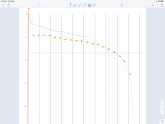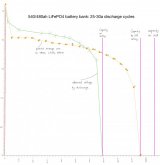I’m in the middle of a discharge capacity test and am using resting cell voltages as my outcome variable, measured against the output through a shunt. The shunt (Victron BMV700) reads instantaneous watts, but cumulative ah, which is unfortunate. I’m trying to simulate realistic conditions so i have a small fridge running non-stop and a dehumidifier running in about 25-30a bursts for an hour, and then off for an hour, then taking my voltage read at the end of the ‘rest’ hour. Finally, I’m graphing it against a standard LiFePO4 discharge curve. Lots of holes in the methodology, but it’s just to give me a better confidence in the capacity. So far, so good. I’ll repeat it with different loads and overlay the results. Any suggestions to make it more accurate an assessment?
Discharge capacity testing
- Thread starter Braddo
- Start date





